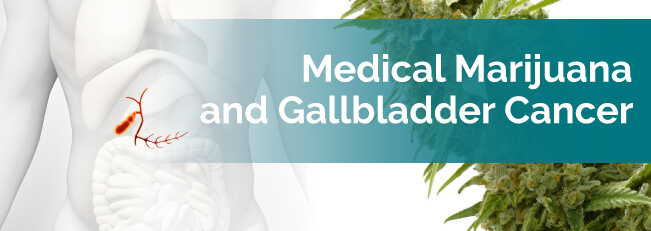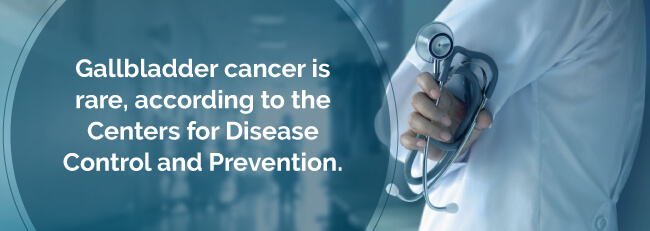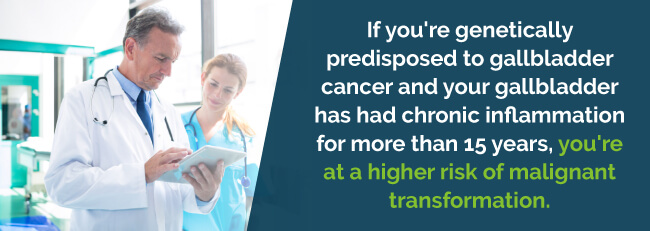
Gallbladder cancer and the treatments for it can leave you feeling fatigued, weak and nauseous. Medical marijuana for gallbladder cancer can help tackle many of the symptoms associated with this type of cancerand its treatment side effects.
Gallbladder cancer originates in your gallbladder, a small, pear-shaped organ just beneath your liver, located on the right side of your abdomen. It stores bile, a digestive fluid your liver produces.
Gallbladder cancer is rare, according to the Centers for Disease Control and Prevention. When doctors identify it in its earlier stages, it increases your chance of being cured. When doctors discover the cancer in its later stages, it can lead to a poor prognosis.

Your risk factors for this cancer increase if you’re female or of Native American ancestry.
Gallbladder cancer is hard to identify and diagnose, since it rarely causes any specific symptoms or signs, especially in its early stages. Also, the gallbladder’s relatively hidden nature makes it harder for doctors to catch the cancer, and it often grows undetected.
Unfortunately, symptoms of gallbladder cancer often don’t manifest until the disease has progressed considerably. However, there have been cases where the warning signs turn up sooner, allowing for an early diagnosis. Some common symptoms of gallbladder cancer include:
Nausea is common with gallbladder cancer, which may or may not lead to vomiting.
You can experience abdominal pain with this cancer. The pain is usually in the upper right section of the stomach.
Your gallbladder may swell to an abnormal size if your cancer blocks your bile ducts. The cancer may also spread to surrounding areas of your liver. Doctors can sometimes feel these as lumps or detect them through ultrasound imaging tests.
Jaundice is where your skin and white part of your eyes become a yellowish color. If your cancer begins growing big enough where it is blocking your bile ducts, liver bile can’t drain from your intestines. This leads to a chemical known as bilirubin, which causes the yellow color of your skin and in the whites of your eyes. Bilirubin builds up in your blood and settles in various parts of your body.
Other less common gallbladder cancer symptoms include:
As mentioned earlier, gallbladder cancer is fairly rare. In many cases, something other than the cancer itself is causing the symptoms. For instance, people also have many of the above symptoms with gallstones, and abdominal pain is a symptom of many conditions. Jaundice is a common cause of viral hepatitis. Even so, see your doctor right away if you’re experiencing these symptoms so you can receive a proper diagnosis.

Because many people with gallbladder cancer present in its advanced stages, to this day, it’s linked with a poor prognosis. Its five-year survival rate is less than 10 percent in Stage III, according to the American Cancer Society, and 4 percent or less in stage IV.
Surgeons must completely remove the gallbladder for an effective treatment. Many incidental gallbladder cancer patients at re-exploration will have residual disease.
Management of patients with gallbladder cancer requires a multidisciplinary approach and a skilled surgeon’s input.
Adenocarcinomas make up around nine out of 10 gallbladder cancers. Adenocarcinomas begin in cells with gland-like properties which line most external and internal body surfaces, including the inside of the digestive system.
Papillary adenocarcinoma is a type of gallbladder adenocarcinoma. The cells in this kind of cancer, when viewed under a microscope, are organized in finger-like projections. They aren’t as likely to grow into nearby lymph nodes or your liver. Their prognosis is better than many types of gallbladder adenocarcinomas. They make up around 6 percent of gallbladder cancers.
Squamous cell carcinomas, adenosquamous carcinomas, sarcomas, small cell carcinomas and other types of cancer can develop in your gallbladder, although they’re not highly prevalent.
Carcinoma of the gallbladder is especially deadly, as indicated by the survival rates discussed above. Since anatomically, the gallbladder doesn’t have a serosa tissue membrane to keep cancer from spreading, and the symptoms are vague, doctors tend to diagnose cancer in more advanced stages, usually with an abysmal prognosis.
If you’re genetically predisposed to gallbladder cancer and your gallbladder has had chronic inflammation for more than 15 years, you’re at a higher risk of malignant transformation.

Like some patients with gallbladder cancer, you may experience depression, anxiety and other psychological stresses, which can impact your digestion, immune system, concentration and sleep.
Mind-body medicine therapy could help reduce your nausea, sleep problems, pain and other side effects to help you cope better during your treatment for your cancer. Mind-body medicine is an integral part of your “whole-person” care. It realizes the powerful ways mental, emotional, behavioral and social factors can affect your physical health directly.
Marijuana for gallbladder cancer is another type of mind-body therapy you may benefit from and can also relieve side effects of your disease and/or treatment. We’ll discuss this in further detail momentarily.
Statistics about gallbladder cancer, according to the National Center for Biotechnology Information, are:
Several factors determine the treatment you receive, including how advanced your cancer is, your preferences, possible side effects and overall health. Your medical care plan might also include therapy for side effects and symptoms, an integral part of cancer care. Consult with your doctor to learn all your treatment options.
During surgery, your surgeon removes the tumor and some of the surrounding healthy tissue.
Three types of surgery to treat gallbladder cancer include:
Any side effects you experience depend on what type of surgery you had. However, typical side effects include:
With radiation therapy, the doctor uses high-energy X-rays to destroy cancer cells. The most common type of radiotherapy for gallbladder cancer is external-beam radiation therapy. A machine gives you therapy outside your body with this type of radiation.
Your surgeon may give you radiation therapy before surgery to shrink your tumor. They may also give you radiation therapy after you’ve already had surgery to destroy any remaining cancer cells.
Side effects of radiotherapy may include:
Most side effects disappear after concluding your treatment.
Chemotherapy uses medications to destroy cancer cells, typically by stopping the cancer cells from growing and dividing. You may receive one medication at a time or a combination of several drugs given simultaneously.
You may receive chemotherapy intravenously by injection or orally by swallowing a capsule or pill. Your doctor may give you chemo before your surgery to shrink your tumor or after you’ve had surgery to destroy any leftover cancer cells. Your oncology team may also combine chemo with radiation therapy.
Common chemo drugs include:
Side effects of chemo depend on the dose used, but typically include:
Side effects usually go away after you finish treatment.
If your cancer recurs or continues to grow despite treatment, newer treatments might help keep it under control. Ask your oncologist if there are any clinical trials for gallbladder cancer you can participate in.
Patients often add marijuana to their cancer regimens in several ways. Some patients use medical cannabis for gallbladder cancer to manage symptoms such as pain, nausea and vomiting. Many already know of the antiemetic properties of marijuana. Even those who aren’t quite sure yet if medical cannabis is right for them acknowledge the benefits it produces as far as nausea relief and appetite stimulation for cancer patients.
Others use an energizing marijuana strain to fight fatigue. Some cancer sufferers use it to lift their moods during this trying time in their lives. Even nurses working with hospice and palliative care patients realize the quality-of-life benefits medical weed provides to individuals who are experiencing the painful effects they get from their cancer treatment.
Still others consume highly concentrated medical marijuana oil and raw cannabis juice in an attempt to use a natural remedy to treat their disease. University of Anglia researchers found THC reduced tumor growth in patients with cancer in 2014. THC is the main psychoactive in marijuana. The research team induced tumors in mice using samples of human breast cancer.

Researchers then began targeting the tumors with cannabis doses high in THC. They found two cell receptors were particularly responsible for the anti-tumor effects of the drug.
Doctors already prescribe marijuana-like pharmaceuticals to help treat chemo side effects. There are two specific synthetic cannabinoids modeled after THC — nabilone and dronabinol — approved for reducing chemo-induced vomiting and nausea.
Many patients with gallbladder cancer experience symptoms such as:
Mostly, these symptoms have a connection with chemotherapy treatment used to treat gallbladder cancer. In fact, according to San Francisco General Hospital Chief Dr. Donald Abrams, every day cancer patients experience vomiting, nausea, pain, loss of appetite, insomnia and depression. To him, medical cannabis is the only anti-nausea drug able to increase your appetite.
Abrams says medical weed also helps elevate his patients’ mood and helps them sleep — not an easy feat when you’re dealing with a life-threatening illness. He says he could just as well prescribe six different prescriptions which would likely interact with chemo or each other. But instead, he’d rather just recommend trying just one medication.
Every strain has a distinct profile — and different strains are effective for different patients. When you’re battling gallbladder cancer, you’ll need a potent medical cannabis for gallbladder strain by your side. Here are some suggestions.
Strains containing high levels of CBD and THC are typically the best at fighting pain because of their synergistic effects. However, you can still benefit from either one of these cannabinoids.

Strains may include:
Strains consisting of at least some level of THC typically deliver anti-nausea effects. You’ll experience the most effects when you vape or smoke the herb.
Strains may include:
When you’re dealing with a loss of appetite, high-THC strains are the way to go. These are usually indica strains.
Strains may include:
When you’re struggling with depression, mood and energy-boosting strains can be the most effective.
Strains may include:
Sativa strains help to eliminate fatigue because of their energetic and rejuvenating buzz. However, hybrids can help as well.
Strains may include:
To find a strain to help a specific symptom, you can work with your budtender at your dispensary.
You may have concerns revolving around smoking your cannabis and gallbladder cancer treatment. No matter what materials you’re smoking, it can produce carcinogens. These are not helpful at all for patients who already have suppressed immune systems due to chemotherapy. But marijuana might not be as carcinogenic as tobacco.
If you’re looking to use marijuana and gallbladder cancer therapy, you may want to try other forms of consumption, such as vaporization, edibles, transdermal patches, suppositories or medical cannabis oil. Whichever is your preferred method to take the medicinal herb, you’ll still first need to search for a medical marijuana dispensary or doctor before you can begin your cannabis treatment.
Find A Doctor Find A Dispensary